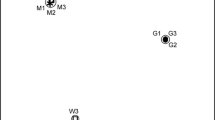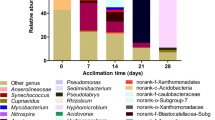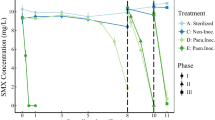Abstract
Complex microbial communities from river biofilms might contain microorganisms capable of degrading xenobiotic pollutants such as pesticides (e.g. methomyl, which is commonly detected in rivers). Therefore, this study was used to determine the methomyl degradation potential of bacteria consortia and single bacterial strains acclimatized and isolated from natural river biofilms to provide biomaterials for bioremediation of water that is contaminated with methomyl. Natural river biofilms were culture enriched with methomyl as the sole carbon source to obtain acclimatized bacterial consortia and single bacterial strains. The microbial consortium on the ceramic discs was able to remove 91 % of added methomyl (50 mg l−1) in 7 days. The longer-acclimatized bacterial consortium on loofah sponges removed methomyl more quickly than the shorter-acclimatized consortium, but both had similar removal capabilities (i.e. 92.4 and 92.2 %). This finding suggested that the former might contain more methomyl degraders than the latter. However, after preservation at 25, 4 and −20 °C for 1 or 3 months, the methomyl degradation ability of the bacterial consortia decreased significantly, indicating loss of methomyl degraders during preservation. Three bacterial species were isolated from acclimatized river biofilms, and only one species, identified as Sphingomonas sp., was able to remove methomyl, with a 7-day removal rate of 44.7 % when sugar was added and of 32.5 % when no sugar was added. These results suggested that an additional carbon source might slightly improve the ability of Sphingomonas sp. to degrade methomyl. Acclimatized bacterial consortia have a higher potential for treating methomyl-contaminated water than isolated bacterial species.




Similar content being viewed by others
References
Araya R, Yamaguchi N, Tani K, Nasu M (2003) Changes in the bacterial community of natural river biofilm during biodegradation of aniline-derived compounds determined by denaturing gradient gel electrophoresis. J Heal Sci 49(5):379–385
Carvalho MF, Alves CCT, Ferreira MIM, De Marco P, Castro PM (2002) Isolation and initial characterization of a bacterial consortium able to mineralized fluorobenzene. Appl Environ Microbiol 68(1):102–105
Chang YJ, Stephen JR, Richter AP, Venosa AD, Brüggemann J, Macnaughton SJ, Kowalchuk GA, Haines JR, Kline E, White DC (2000) Phylogenetic analysis of aerobic freshwater and marine enrichment culture efficient in hydrocarbon degradation: effect of profiling method. J Microbiol Method 40(1):19–31
Crump BC, Bahr GW, Michele B, Hobbie JE (2003) Bacterioplankton community shifts in an arctic lake correlate with seasonal changes in organic matter source. Appl Environ Microbiol 69(4):2253–2268
Dasgupta D, Ghosh R, Sengupta TK (2013) Biofilm-mediated enhanced crude oil degradation by newly isolated Pseudomonas species. ISRN Biotechnol 2013:1–13
El-Fakharany II, Massoud AH, Derbalah AS, Saad Allah MS (2011) Toxicological effects of methomyl and remediation technologies of its residues in an aquatic system. J Environ Chem Ecotoxicol 3(13):332–339
Farré M, Fernandez J, Paez M, Granada L, Barba L, Gutierrez HM, Pulgarin C, Barceló D (2002) Analysis and toxicity of methomyl and ametryn after biodegradation. Anal Bioanal Chem 373(8):704–709
Ferris MJ, Muyzer G, Ward DM (1996) Denaturing gradient gel electrophoresis profiles of 16S rRNA-defined populations inhabiting a hot spring microbial mat community. Appl Environ Microbiol 62(2):340–346
Fredrickson JK, Balkwill DL, Drake GR, Romine MF, Ringelberg DB, White DC (1995) Aromatic-degrading Sphingomonas isolates from the deep subsurface. Appl Environ Microbiol 61(5):1917–1922
Harms H, Wilkes H, Wittich RM, Fortnagel P (1995) Metabolism of hydroxydibenzofurans, methoxydibenzofurans, acetoxydibenzofurans and nitrobenzofurans by Sphingomonas sp. strain HH69. Appl Environ Microbiol 61(7):2499–2505
Heuer H, Drsek M, Baker P, Smalla K, Wellington EMH (1997) Analysis of actinomycete communities by specific amplification of genes encoding 16S rRNA and gel-electrophoretic separation in denaturing gradients. Appl Environ Microbiol 63(8):3233–3241
Hitchcock AP, Dynes JJ, Lawrence JR, Obst M, Swerhone GDW, Korber DR, Leppard GG (2009) Soft X-ray spectromicroscopy of nickel sorption in a natural river biofilm. Geobiology 7(4):432–453
Huang X, Tian Y, Luo YR, Liu HJ, Zheng W, Zheng TL (2008) Modified sublimation to isolate phenanthrene-degrading bacteria of the genera Sphingomonas and Burkholderia from Xiamen oil port. Mar Poll Bull 57(6–12):538–543
Huertas MJ, Luque-Almagro VM, Martínez-Luque M, Blasco R, Moreno-Vivián C, Castillo F, Roldán MD (2006) Cyanide metabolism of Pseudomonas pseudoalcaligenes CECT5344: role of siderophores. Biochem Soc Trans 34(Pt 1):152–155
Imai Y, Kuwatsuka S (1986) The mode of metabolism of the herbicide molinate by four strains of microorganisms isolated from soil. J Pest Sci 11(2):111–117
Lang E, Malik KA (1996) Maintenance of biodegradation capacities of aerobic bacteria during long-term preservation. Biodegradation 7(1):65–71
Lawrence JR, Kopf G, Headley JV, Neu TR (2001) Sorption and metabolism of selected herbicides in river biofilm communities. Can J Microbiol 47(7):634–641
Lyautey E, Lacoste B, Ten-Hage L, Rols J-L, Garabetian F (2005) Analysis of bacterial diversity in river biofilms using 16S rDNA PCR-DGGE: methodological settings and fingerprints interpretation. Water Res 39(2–3):380–388
Madhuri RJ, Rangaswamy V (2009) Biodegradation of selected insecticides by Bacillus and Pseudomonas sps in ground nut fields. Toxicol Inter 16(2):127–132
Malato S, Blanco J, Cáceres J, Fernández-Alba AR, Agüera A, Rodríguez A (2002) Photocatalytic treatment of water-soluble pesticides by photo-Fenton and TiO2 using solar energy. Catal Today 76(2–4):209–220
Mohamed MS (2009) Degradation of methomyl by the novel bacterial strain Stenotrophomonas maltophilia M1. Electron J Biotechnol 12(4):1–6
Muyzer G, deWall EC, Uitterlinden AG (1993) Profiling of complex microbial populations by denaturing gradient gel electrophoresis analysis of polymerase chain reaction-amplified genes coding for 16S rRNA. Appl Environ Microbiol 59(3):695–700
Nagas H, Pattanasupong A, Sugimoto E, Tani K, Nasu M, Hirata K, Miyamoto K (2006) Effect of environmental factors on performance of immobilized consortium system for degradation of carbendazim and 2,4-dichlorophenoxyacetic acid in continuous culture. Biochem Eng J 29(1):163–168
Nam IH, Chang YS, Hong HB, Lee YE (2003) A novel catabolic activity of Pseudomonas veronii in biotransformation of pentachlorophenol. Appl Microbiol Biotechnol 62(2–3):284–290
Ni’matuzahroh, Gilewicz M, Guiliano M, Bertrand JC (1999) In-vitro study of interaction between photooxidation and biodegradation of 2-methylphenanthrene by Sphingomonas sp. 2MPII. Chemosphere 38(11):2501–2507
Norhani J, Firdausi R (2008) Microbial consortia from residential wastewater for bioremediation of phenol in a chemostat. J Teknol 48(F):51–60
Ohshiro K, Kakuta T, Sakai T, Hirota H, Hoshino T, Uchiyama T (1996) Biodegradation of organophosphorus insecticides by bacteria isolated from turf green soil. J Ferm Bioeng 82(3):299–305
O’Mahony MM, Dobson AD, Barnes JD, Singleton I (2006) The use of ozone in the remediation of polycyclic aromatic hydrocarbon contaminated soil. Chemosphere 63(2):307–314
Pattanasupong A, Nagase H, Inoue M, Hirata K, Tani K, Nasu M, Miyamoto K (2004a) Ability of a microbial consortium to remove pesticide, carbendazim and 2,4-dichlorophenoxyacteic acid. World J Microbiol Biotechnol 20(5):517–522
Pattanasupong A, Nagase H, Sugimoto E, Hori Y, Hirata K, Tani K, Nasu M, Miyamoto K (2004b) Degradation of carbendazim and 2,4-dichlorophenoxyacetic acid by immobilized consortium on loofa sponge. J Biosci Bioeng 98(1):28–33
Rowan A, Snape J, Fearnside D, Barer M, Curtis T, Head I (2003) Composition and diversity of ammonia-oxidizing bacterial communities in wastewater treatment Reactors of different design treating identical wastewater. FEMS Microbiol Ecol 43(2):195–206
Schmidt S, Witttich RM, Erdmann D, Wilkes H, Francke W, Fortnagel P (1992) Biodegradation of diphenyl ether and its monohalogenated derivatives by Sphingomonas sp. strain SS3. App. Environ Microbiol 58(9):2744–2750
Sharmila M, Ramanand K, Sethunathan N (1989) Effect of yeast extract on the degradation of organophosphorus insecticides by soil enrichment and bacterial cultures. Can J Microbiol 35(12):1105–1110
Singh R, Trivedi VD, Phale PS (2013) Metabolic regulation and chromosomal localization of carbaryl degradation pathway in Pseudomonas sp. strains C4, C5 and C6. Arch Microbiol 195(8):521–535
Tamboli DP, Kurade MB, Waghmodeb TR, Joshi SM, Govindwar SP (2010) Exploring the ability of Sphingobacterium sp. ATM to degrade textile dye Direct Blue GLL, mixture of dyes and textile effluent and production of polyhydroxyhexadecanoic acid using waste biomass generated after dye degradation. J Hazard Mater 182(1–3):169–176
Tien C-J, Chuang T-L, Chen CS (2011) The role of naturally occurring river biofilms on the degradation kinetics of diazinon. Clean: Soil, Air, Water 39(10):931–938
Tien C-J, Lin M-C, Chiu W-H, Chen CS (2013) Biodegradation of carbamate pesticides by natural river biofilms in different seasons and their effects on biofilms community structure. Environ Poll 179:95–104
USEPA (1998) Reregistration eligibility decision (RED)- Methomyl List A, Case 0028. EPA 738-R-98-021. Office of Prevention, Pesticides and Toxic Substances (7508C), United States Environmental Protection Agency, Washington, DC, 20460
Van Scoy AR, Yue M, Deng X, Tjeerdema RS (2013) Environmental fate and toxicology of methomyl. Rev Environ Contam Toxicol 222:93–109
Weisburg WG, Barns SM, Pelletier DA, Lane DJ (1991) 16S ribosomal DNA amplification for phylogenetic study. J Bacteriol 173(2):697–703
White DC, Sutton SD, Ringelberg DB (1996) The genus Sphingomonas: physiology and ecology. Curr Opin Biotechnol 7(3):301–306
Wittich RM, Wilkes H, Sinnwell V, Francke W, Fortnagel P (1992) Metabolism of dibenzo-p-dioxin by Sphingomonas sp. strain RW1. Appl Environ Microbiol 58(3):1005–1010
Xu J-L, Wu J, Wang Z-C, Wang K, Li M-Y, Jiang J-D, He J, Li S-P (2009) Isolation and characterization of a methomyl-degrading Paracocus sp. mdw-1. Pedosphere 19(2):238–243
Ye YF, Min H, Du YF (2004) Characterization of a strain of Sphingobacterium sp. and its degradation to herbicide mefenacet. J Environ Sci (China) 16(2):343–347
Acknowledgments
This work was funded by National Science Council, Taiwan with the project no. NSC96-2313-B-017-001-MY3.
Author information
Authors and Affiliations
Corresponding author
Rights and permissions
About this article
Cite this article
Chen, C.S., Wu, TW., Wang, HL. et al. The ability of immobilized bacterial consortia and strains from river biofilms to degrade the carbamate pesticide methomyl. Int. J. Environ. Sci. Technol. 12, 2857–2866 (2015). https://doi.org/10.1007/s13762-014-0675-z
Received:
Revised:
Accepted:
Published:
Issue Date:
DOI: https://doi.org/10.1007/s13762-014-0675-z




